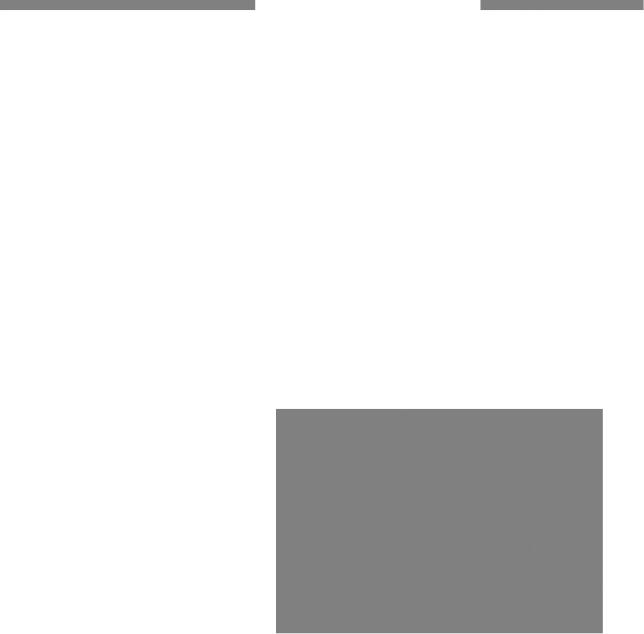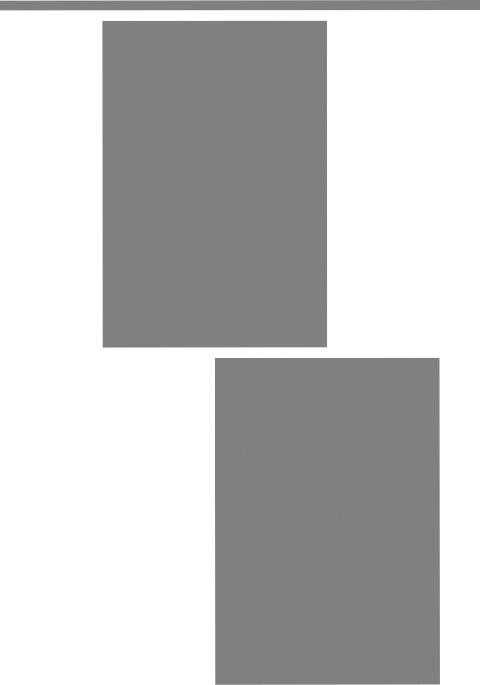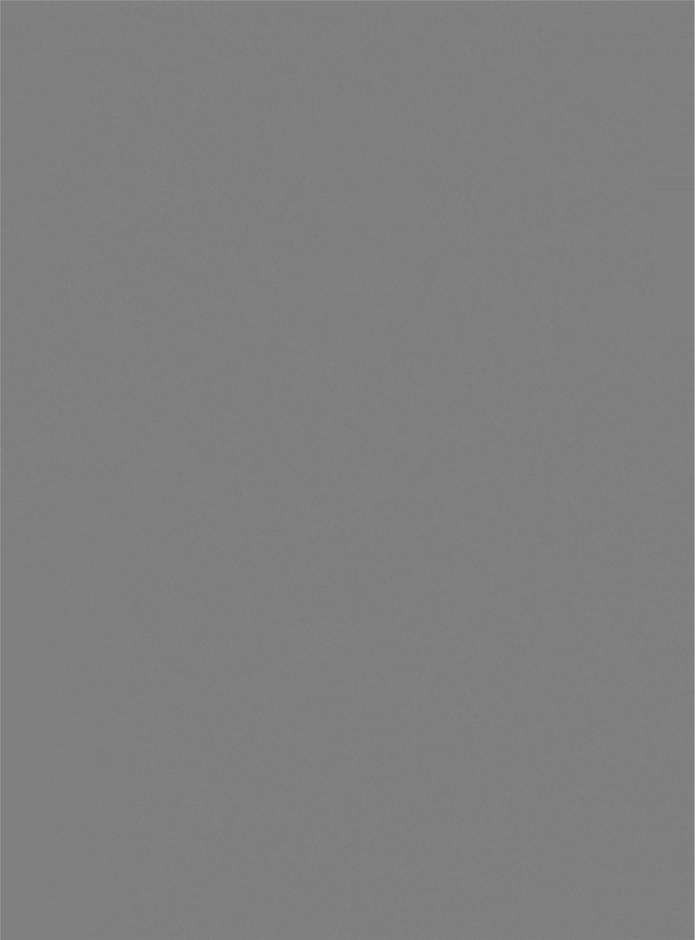
Учебники / Rhinoplasty Dissection Manual Toriumi 1999
.pdfFigure 5. Cross-section at the level of the cartilaginous vault
(A). The nasal mucoperichon drium provides support to the up per lateral cartilages and helps decrease the risk of inferomedial collapse of the upper lateral car tilages after hump excision (B, e). When the nasal mucoperi chondrium is violated, inferome dial collapse of the upper lateral cartilages may occur (D, E).
A
B
the nasal bones can lead to an "inverted V deformity," in which the upper lateral c collapse inferomedially, and the caudal edges of the nasal bones are visible in bro creating an unacceptable appearance.] (3,4 ) (Appendix G)
Now make additional fine-tuning modifications to the cartilaginous dorsum as i Examination of the excised hump may guide any additional excision. Trim the (dorsal) margins of the upper lateral cartilages such that they lie on a level with o low that of the trimmed border of the septum. Additional modification of the bony also may be required.
An "open roof" may be created by hump removal. The bony margin s should smoothed with a rasp by using few but firm strokes (Fig. 6). Any bony fragments s removed, making sure that all obvious particles are removed from under the s tissue envelope.
An alternative to the manual rasp is a powered reciprocating rasp or sheathed bu 7 and 8) (5). These instruments can be used wherever a manual rasp would be used , less soft-tissue trauma. The site to be treated can be directly visualized. The pow struments are especially useful to smooth the bony marg ins of the open roof. They useful to correct isolated bony irregularities that may be encountered, for exampl ond ary rhinoplasty. It appears that a more reproducible result can be obtained with incidence of visible or palpable bony dorsal irregularities. After rasping or burri particles should be irrigated from the surgical site .

Figure 6. Smooth the bony margins with a rasp by using few but firm strokes , cutting only on the downstroke.
Figure 7. The powered reciprocating rasp is an alternative to the manual rasp.



7
Osteotomies
MEDIAL OSTEOTOMIES
To perform medial osteotomies, insert the osteotome at the jun ction between the nasal bone and sep tum. With the two-tap technique, advance the cutting edge cephalad and fade laterally as the frontal bone is reached (Fig. 1). Control the sharp leading edge of the chisel, as it moves under the skin, with the forefinger of the nondominant hand . Thi s fading me dial osteotomy avoids the thick frontal bone. Medial osteotomies are usually not necessary in cases in which large dorsal humps are excised, leaving an open-roof deformity .
LATERAL OSTEOTOMIES AND INFRACTURE
[Note : The dissector may wish to mark the site of the propo sed osteot omy on the skin be fore proceedin g. Perform the lateral osteotomy on one side , and then reflec t the skin/soft tissue envelope laterally to exa mine it. Is it in proper position? Is the periosteum intact, or has it been violated ? Is the mucoperio steum intact?
After assessing the first lateral osteotomy, the skin of the oppo site side may be reflected before the osteotomy. Th is will allow observation of the osteotom y unde r direct vision.]
T he lateral osteotomi es run from the most lateral point of the pyriform aperture to a point medial to the inner ca nthus of the eye, taking a high to low to high path . In practice, this means a starting point 3 mm to 4 mm abo ve the base of the pyriform aperture and adja cent to the head of the inferior turbinate. The high-to-low lateral osteotomy preser ves a small triangle of bone at the base of the pyriform aperture (Fig . 2) . Use a 2-mm (unguarded ) or 3-mm (guarded or unguarded) curved or flat osteotom e. Use a guarded or unguarded os teotome based on preference.
Make a small incision near the base of the pyriform apertur e. Althou gh it is not essen tial, many surgeons create a short subperiosteal tunnel along the path of the proposed lat eral osteotomy . Seat the osteotome on the bone 3 mm to 4 mm above the base of the pyri form aperture, and use a gentle two-tap technique to advance the osteotome gradually. An gle the osteotome in a posterior and cephalic direction initially, and then adjust the os teotome so that the cutting edge travels toward a point medi al to the inner canthus of the eye. Thi s creates the typical high-to-low-to-high lateral osteotomy . Control the cutting edge by palpation with the thumb or fingers of the nondominant hand as the osteotome travels toward the inner canthus. When the osteotome approaches the level of the inner canthus,
67

I. Tardy ME. Rhinoplasty: the art and the science. Philadelphia: WB Saunders, 1997.
2. Larrabee WF Jr. Open rhinoplasty and the upper third of the nose. Facial Plast Surg Clin North Am 1993; 1: 23-28.
3.Johnson CM Jr, Toriumi DM. Open structure rhinoplasty. Philadelphia: WB Saunders, 1990.
4.Murakami CS, Larrabee WF. Comparison of osteotomy techniques in the treatment of nasal fractures. Facial
Plast Surg 1992;8:209-219.
5. Farrior RT. The osteotomy in rhinoplasty. Laryngoscope 1978;88: 1449.
6.Thomas JR, Griner NR, Remmler DJ. Steps for a safer method of osteotomies in rhinoplasty. Laryngoscope 1987;97:746-747.
8
Spreader Grafts
Spreader grafts may be placed endonasally or via the external rhinoplasty approach. If en donasal placement of spreader grafts is done in this dissection, undertake this before hump reduction and osteotomies.
Through a small (5-mm) mucosal incision near the anterior septal angle, develop a pre cise subperichondrial pocket along the length of the cartilaginous dorsum near the junction of the dorsal septum and upper lateral cartilage (Fig. 1). A Cottle or Freer elevator can be used to elevate the subperichondrial tunnels. Special care must be taken to get into the sub perichondrial plane; otherwise, the mucosa may tear. Additionally, avoid pushing the ele vator through the septum to the other side. Fashion rectangular spreader grafts that extend from the osseocartilaginous junction to the internal nasal valve where the upper lateral car tilage meets the dorsal septum. Appropriate thickness can be determined to achieve the de sired functional effect without causing excessive widening, usually I mm to 3 mm in thick ness. Experience is required to develop reliable surgical judgment regarding the appropriate width and length of spreader grafts. Insert the grafts into the precise subperi chondrial tunnels, taking great care to preserve the mucosa (see Fig. 1).
[Note: After placing endonasal spreader grafts, return to Chapter 6 and perform hump excision and then osteotomies. To exam.ine the precise pocket that was made before hump removal, separate the upper lateral cartilage from the septum, as described below and il lustrated in Fig. 2.]
Division of the upper lateral cartilages from their attachment to the dorsal septum is un dertaken in the submucoperichondrial plane (see Fig. 2). This may be done before hump excision, or in cases in which no hump excision is necessary. Alternatively, this maneuver may be undertaken after hump excision. Again, great care should be taken to preserve an intact mucoperichondrium.
The accompanying figures (Figs. 2 through 6) illustrate placement of spreader grafts through the external rhinoplasty approach. At this point, the dissector should have under taken hump reduction and osteotomies. (If hump removal has not been completed, return to Chapter 6). Spreader grafts are placed into pockets between upper lateral cartilage and dorsal septum (Figs. 3 and 4). A typical graft extends from the osseocartilaginous junction to the anterior septal angle. The spreader grafts are secured with absorbable suture [we rec ommend 5-0 polydioxanone suture (PDS), Monacryl, or other similar suture]. The spreader
71

